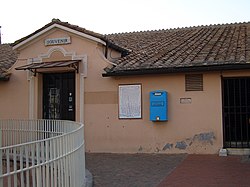 View of St. Peter's Square from the top of Michelangelo's dome | |
| Currency | Euro (EUR) |
|---|---|
| Calendar year | |
| Statistics | |
| GDP | 19.80 M |
GDP growth | 0% |
GDP per capita | US$27,461 |
| 6.9% | |
Population below poverty line | 0% |
| 35.16 | |
Labour force | 4,822 (2016) |
Labour force by occupation | note: essentially services with a small amount of industry; nearly all dignitaries, priests, nuns, guards, and the approximately 3,000 lay workers live outside the Vatican |
Main industries | printing, production of coins, medals, postage stamps, mosaics and staff uniforms and financial services |
| Public finances | |
| Revenues | €770 million (2021) |
| Expenses | €803 million (2021) |
All values, unless otherwise stated, are in US dollars. | |
 |
| This article is part of a series on |
| Vatican City |
|---|


The economy of Vatican City is mainly supported financially by the sale of stamps, coins, medals, and tourist mementos as well as fees for admission to museums and publication sales. Vatican City employed 4,822 people in 2016. [1]
Contents
The Vatican City receives subsidies from the Italian state, which include the water supply free of charge, tax exemptions and other kinds of dedicated public funding.
Vatican City issues its own coins and stamps. It has used the euro as its currency since 1 January 1999, owing to a special agreement with the European Union (council decision 1999/98). Euro coins and notes were introduced on 1 January 2002—the Vatican does not issue euro banknotes. Issuance of euro-denominated coins is strictly limited by treaty, though somewhat more than usual is allowed in a year in which there is a change in the papacy. [2] Because of their rarity, Vatican euro coins are highly sought by collectors. [3]
 |  |  |
Vatican euro coins with images of Pope Francis and Pope Benedict XVI